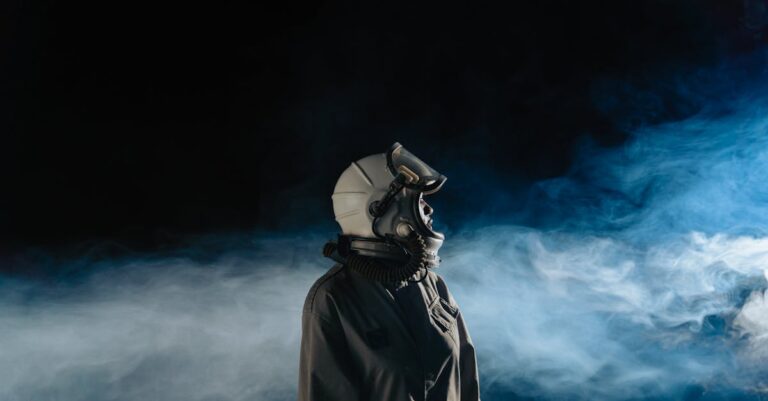
The air reeked of ozone and rust, a metallic tang that clung to the back of Dr. Elara Voss’s throat as she adjusted the visor on her helmet. Outside the colony’s domed perimeter, the twin suns of Thalassa hung low on the horizon, casting jagged shadows across the obsidian plains. The ground here was not soil but a dense, glassy crust, cracked like dried riverbeds, and every step she took sent faint vibrations through her boots. She paused, scanning the horizon where the sky bled into a violet haze, the atmosphere thick with unidentifiable particles that refracted the sunlight into prismatic shards.
“You’re not supposed to be out here alone,” came a voice over her earpiece, sharp and clipped. Lieutenant Kael Ren’s tone was laced with irritation, though Elara knew it was mostly for show. He’d been assigned to monitor her, a bureaucratic formality she’d long since stopped taking seriously.
“I needed to collect samples from the fissure zone,” she replied, crouching to scrape a gloved hand over the glassy surface. The material crumbled under her touch, releasing a faint hiss of trapped gas. “The readings from the last batch were… inconsistent.”
A pause. Then, “You’re chasing ghosts, Voss. The council’s not going to buy another report about ‘anomalies.’”
Elara straightened, her jaw tightening. “It’s not a ghost. It’s a pattern. The energy fluctuations, the mineral deposits—there’s something here that doesn’t fit the models.”
“Then bring a team next time,” Kael said, his voice softening just enough to hint at concern. “This place isn’t safe.”
She didn’t respond. The colony’s warnings about Thalassa’s instability were well known, but Elara had seen too many data points to ignore. The fissures, the erratic magnetic fields, the way the air itself seemed to hum with an unseen current—all of it pointed to a force beyond their understanding. And she was determined to find out what it was.
—
The sample chamber was cold, its walls lined with steel panels that reflected the harsh glow of overhead lights. Elara placed the vial on the workbench, her breath visible in the low humidity. Inside, the substance shimmered like liquid mercury, shifting between hues of blue and green as it reacted to the lab’s electromagnetic field. She adjusted the spectrometer, her fingers moving with practiced precision.
“What are we looking at?” Kael’s voice cut through the silence, though he remained in the doorway, his arms crossed over his chest.
“A compound that shouldn’t exist,” she said, not looking up. “It’s not just reactive—it’s *alive*.”
Kael stepped closer, his brow furrowed. “You’re saying it’s… sentient?”
“Not in the way you’re thinking,” she said, her voice tight. “It’s responding to stimuli. The energy patterns match nothing in our databases. It’s like it’s *learning* from us.”
A low hum filled the chamber, and the vial’s contents pulsed faintly. Kael took a step back, his hand hovering near his sidearm. “We need to report this.”
“And risk being shut down?” Elara’s eyes flashed with defiance. “You think the council would let us study something like this? They’d bury it.”
“Then we find another way,” Kael said, his tone steady. “But we do it together.”
Elara hesitated, the weight of his words settling over her. She had spent years pushing boundaries, chasing theories that others dismissed as nonsense. But this—this was different. This was a discovery that could change everything. And she wasn’t ready to let it go.
—
The storm came without warning.
Elara had seen the weather reports, the predictions of ionized storms sweeping across the plains, but nothing could have prepared her for the sheer force of it. The sky darkened to a deep indigo, and the air thickened with charged particles that crackled against her helmet. Lightning arced across the horizon, illuminating the jagged peaks of distant rock formations in stark, blue-white flashes.
“We need to get back!” Kael’s voice was barely audible over the howling wind. He grabbed her arm, pulling her toward the colony’s entrance. The doors were already closing, sealed against the storm’s fury.
Elara wrenched free, her boots slipping on the glassy ground. “No! We can’t leave it!”
“You’re insane!” Kael shouted, his face a mask of frustration. “That thing could kill us!”
“It’s not a thing!” she yelled back, her voice raw. “It’s *trying* to communicate!”
The storm surged, and the ground beneath them trembled. A fissure split open near the edge of the plain, spewing a plume of violet smoke that twisted into the air like a living entity. Elara froze, her breath catching as the smoke coalesced into shapes—abstract forms that pulsed with light, shifting and re-forming in an endless cycle.
“Elara!” Kael’s hand closed around her wrist, dragging her backward as the fissure widened. The air shimmered, and for a brief moment, she saw it: a vast, shifting network of light and shadow, a web of connections that stretched beyond the horizon. It was beautiful. Terrifying. *Alive.*
“We have to go,” Kael said, his voice urgent. “Now.”
She nodded, her legs shaking as they sprinted toward the colony. The storm raged behind them, but Elara’s mind was already elsewhere, tracing the patterns she’d seen in the smoke. This was only the beginning.
—
The council meeting was a battlefield of words.
Elara stood at the head of the long, circular table, her hands gripping the edge as she faced the seven members of the Thalassa Oversight Committee. Their faces were etched with skepticism, their eyes narrowed as they listened to her report. The vial of reactive substance sat in front of her, its surface still pulsing with faint light.
“You’re asking us to believe that a non-organic compound is *learning* from us,” said Councilor Maren, her voice cold. “This is not science, Elara. This is speculation.”
“It’s data,” Elara countered, her voice steady. “The energy patterns, the responses—there’s a clear progression. It’s adapting.”
“And what do you propose we do with this ‘data’?” interjected Councilor Rhen, his tone sharp. “We can’t risk destabilizing the colony for the sake of a theory.”
Elara exhaled, forcing herself to remain calm. “I’m not asking for a full-scale investigation. Just access to the research facilities. I need time to analyze the compound further.”
“Time is a luxury we don’t have,” Maren said. “The storm last week nearly compromised the colony’s power grid. We’re not here to play with forces we don’t understand.”
“You’re afraid,” Elara said, her voice low. “Afraid of what this means. Afraid that we’re not alone in this universe.”
A tense silence followed. Then, Rhen spoke, his words deliberate. “We are not afraid. We are cautious. And caution is what has kept this colony alive for over a decade.”
Elara’s jaw tightened. She had expected resistance, but the sheer dismissal of her findings stung more than she’d anticipated. She had spent her life chasing the unknown, and now, when she was closest to an answer, they wanted to shut her down.
“Then I’ll find another way,” she said, standing tall. “I won’t stop.”
The council members exchanged glances, but no one challenged her. They knew she would. And they knew that, eventually, the truth would find its way to the surface—no matter how hard they tried to bury it.
—
The underground lab was hidden beneath the colony’s maintenance sector, a relic from the early days of Thalassa’s colonization. Elara had discovered it by accident, a forgotten archive of old research notes and experimental data that no one else seemed interested in. But she had seen something in the records—something that connected the fissures, the storms, and the reactive compound.
The air was damp, the walls lined with rusting equipment and faded screens that flickered with static. She ran her fingers over a dusty console, activating it with a hesitant touch. The screen lit up, revealing a series of diagrams and equations that mirrored the patterns she’d seen in the storm.
“You shouldn’t be here,” Kael’s voice echoed from the doorway. He stepped inside, his expression guarded. “This place is off-limits.”
“I needed answers,” Elara said, not looking up. “The council won’t listen. But this… this is real.”
Kael approached, his eyes scanning the screen. “What am I looking at?”
“A map,” she said, pointing to a series of interconnected lines that pulsed with faint light. “This isn’t just a planet. It’s a network. A system. And that compound—we’re not just studying it. We’re part of it.”
Kael frowned. “You’re saying this place is… alive?”
“Not in the way you think,” she said, her voice tinged with urgency. “It’s a construct, a mechanism designed to interact with life forms. The fissures, the storms, the energy fluctuations—they’re all part of a process. And we’ve triggered it.”
A long silence stretched between them. Then Kael spoke, his voice quiet. “If this is true… what happens next?”
Elara didn’t answer immediately. She stared at the screen, the patterns shifting and reforming as if they were alive. The truth was terrifying, but it was also undeniable. They weren’t just visitors on Thalassa. They were part of something far greater—something that had been waiting for them all along.
“We find out,” she said finally. “Before it’s too late.”


